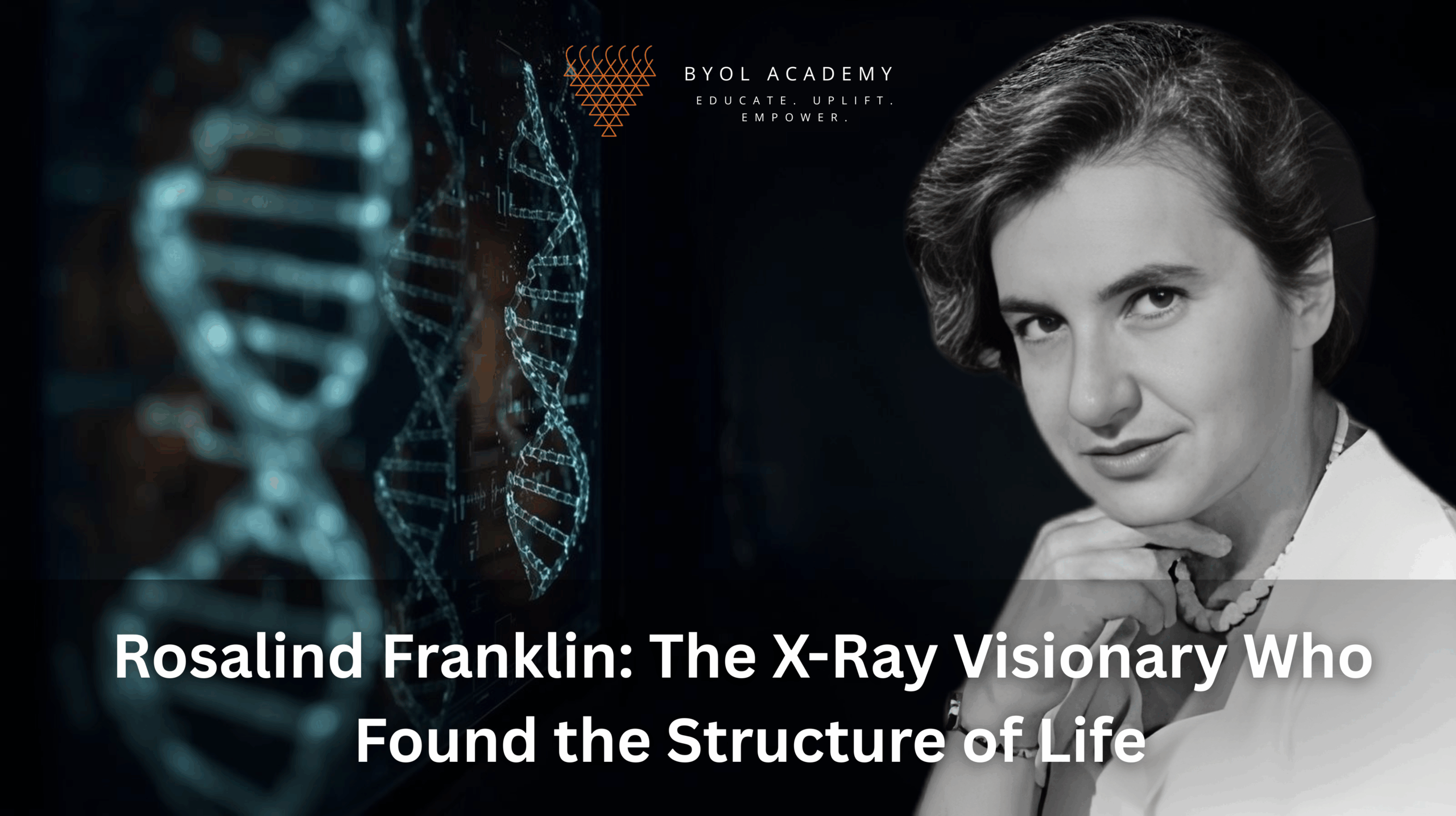Teenage years are the foundation of one’s physical and mental development. It’s the stage when the body grows rapidly, the […]
Rosalind Franklin: The X-Ray Visionary Who Found the Structure of Life

There are a few names that stand out in the grand story of science, and Rosalind Franklin is one of them. Her intelligence, accuracy, and determination changed the way people think about life itself. But for many years, her name was lost in history, often behind the names of her male peers. It is impossible to talk about the discovery of the DNA double helix today without acknowledging Franklin’s pioneering work and the impact it had on science Life and Schooling as a Child.
Early Life and Education
Rosalind Elsie Franklin was born on July 25, 1920, in London, England, to a Jewish family that was well-educated and supportive. She was highly proficient at maths and science when she was a kid. People told Franklin to do what most girls her age did, but she was always interested in Science. Her family recognised her talent early on and helped her reach, her goals. In the early 1900s, this was a rare opportunity for a woman.
She went to Newnham College in Cambridge to learn natural sciences In 1941, she graduated from college. Even though there were gender barriers in academia at the time, Franklin’s sharp mind and hard work stood out. She joined the British Coal Utilisation Research Association during World War II. She learnt a great deal about the properties of coal and carbon, which significantly contributed to the war effort. One way she helped society was by developing better fuels and gas masks.
An Exploration of X-Ray Crystallography
After the war, Franklin moved to Paris to work as a researcher at the Laboratoire Central des Services Chimiques de l’État there she learnt how to use X-ray crystallography, which would later become her most famous work. To determine out the atomic and molecular structure of crystalline materials, this complex method involved directing X-rays at them and analysing the diffraction patterns that came out.
Franklin was a great expert in this field. She was one of the best crystallographers of her time because she was very precise, patient, and good at figuring out complex patterns. Franklin was different from other women at the time because she was smart and clear-headed. She didn’t just do things the right way; she made them better.
The DNA Find
Franklin returned to London in 1951 to join the Biophysics Unit at King’s College. Her new job was to look into DNA, the molecule that carries the genetic information for life. Scientists knew that DNA was involved in heredity, but they didn’t know what it looked like back then. Franklin used what she knew about X-ray diffraction to take some of the clearest and most detailed pictures of DNA ever. One of her best pictures was Photo 51. This picture showed how DNA is shaped like a spiral staircase, which is its own unique shape. It was the key that let you in on the secret of living.
James Watson and Francis Crick were also at the University of Cambridge trying to figure out the structure of DNA. They got Franklin’s work, but she didn’t know about it. They used her data, especially the important information from Photo 51, to create their well-known model of the DNA double helix. In 1962, Watson, Crick, and Maurice Wilkins won the Nobel Prize in Physiology or Medicine. Franklin, who died four years before, didn’t get any credit.
The Virus Research: Beyond DNA
Franklin’s scientific journey didn’t end with DNA, even though no one else saw it that way. After leaving King’s College in 1953, she worked in J.D. Bernal’s lab at Birkbeck College. She studied viruses there using X-ray crystallography. She laid the groundwork for modern virology by carefully studying the tobacco mosaic virus (TMV) and the polio virus. She found out how the RNA in these viruses was put together, which is an important step towards figuring out how viruses spread and infect their hosts.
Her work not only helped basic science move forward, but it also helped make vaccines and learn more about how viruses spread and make people sick. This is an accomplishment that still helps people today.
Other Contributions to Science
Rosalind Franklin was smart in a lot of other areas besides DNA. Her scientific curiosity drove her to investigate various research domains that still impact science and industry today.
1. Virology of Structures
Franklin left King’s College in 1953 and went to work in J.D. Bernal’s lab at Birkbeck College, where she used her knowledge of X-ray crystallography to study viruses.
Her important research on the tobacco mosaic virus (TMV) helped create the field of structural virology. She found out how the RNA of TMV was arranged inside its protein shell. This was the first time anyone had a clear picture of how viruses are built.
Later, she also worked on the polio virus and learnt a lot about how it’s made and how it copies itself. These studies laid the groundwork for contemporary virology and vaccine research. Even today, scientists use her methods to look into the structures of complicated viruses, like the ones that make people sick.
2. Research on Coal and Graphite
Franklin made important discoveries about coal and carbon before she worked on DNA. Her research showed how carbon and coal change structure when they are heated. This information was very useful to the coking industry, which makes materials used in making steel and fuel.
People in industry still use her system for putting different kinds of carbon into groups. This early stage of her career showed how adaptable she was and how well she could connect scientific theory with real-world uses.
3. Heritage
Franklin’s contributions to the discovery of DNA were not well-known at first, but now she is widely praised for her important work in science. She broke down barriers at a time when women in research were often pushed to the side, showing that being good at science has nothing to do with gender.
Her methods, especially in X-ray diffraction, are still very important in structural biology and virology. Her name is now on institutions, awards, and even spacecraft. For example, the Rosalind Franklin Institute in the UK and the Rosalind Franklin Mars Rover, which is part of the European Space Agency’s mission.
Accomplishments and Praise
Rosalind Franklin never got the credit she deserved while she was alive, but her work has since been praised all over the world. Some of her most important accomplishments are:
1. Pioneering Work on DNA Structure: Franklin’s X-ray diffraction images gave scientists the first proof that DNA has a double helix structure, which is probably the most important discovery in modern biology.
2. Contributions to Virology: Her research on the structures of TMV and the polio virus helped scientists understand the molecular composition of viruses, influencing vaccine development.
3. Coal and Carbon Research: Her early work on coal and graphite had a big impact on industry, making the materials used in wartime technologies better.
4. Recognition after death: Franklin’s name has rightfully been restored to its place in scientific history over time. The Rosalind Franklin University of Medicine and Science in the US and the Rosalind Franklin Institute in the UK are two examples of institutions, awards, and research centres that now bear her name.
5. A Legacy of Inspiration: Franklin became a symbol of hard work, honesty, and excellence in science, in addition to her technical achievements. She inspired many women to become researchers even though society made it hard for them to do so.
What she did for society
Rosalind Franklin’s work goes beyond labs and books. Her findings changed how we think about life at the molecular level, which led to huge improvements in medicine, genetics, and biotechnology. The DNA structure she helped identify made it possible to do genetic engineering, forensic science, and genome sequencing and find out if someone has a genetic disease.
In addition, her story has become a rallying cry for equality and fairness in science. Franklin’s story is similar to those of many women who work in research: they are smart people who often go unnoticed in a field that is mostly men. Her life today is both an inspiration and a reminder of how important it is to be honest and respectful of everyone’s work.
The Human Side of Rosalind Franklin
Franklin was known for being smart, but she was also very human, determined, curious, and kind. Her coworkers said she was strict and hard to please, but they also said she was nice, funny, and very loyal to her friends and family. She was a scientist who thought both the big and small things in the world were beautiful. She liked to hike, travel, and spend time outside.
Rosalind Franklin died of ovarian cancer in 1958, when she was only 37 years old. But she did more in her short life than most people do in a whole lifetime. Her quiet dedication to truth and discovery still has an effect on science today.
In conclusion
Rosalind Franklin may not have lived to see her work fully recognised, but her work is still important in every strand of DNA studied today. She wasn’t just a scientist; she was a pioneer. She was a woman who dared to ask questions, look into things, and see things that other people couldn’t. Her work helped scientists figure out the very code of life, which changed science forever.
We celebrate more than just a discovery when we honour Rosalind Franklin. We celebrate the spirit of curiosity, honesty, and hard work that drives all of science. Her story reminds us that truth can bend and twist, just like the double helix she showed us. But it always finds its way into the light.


